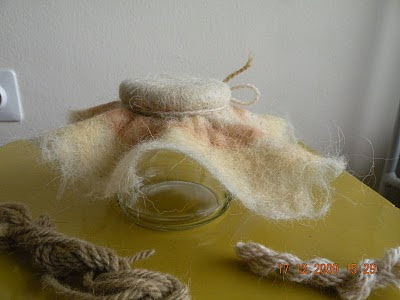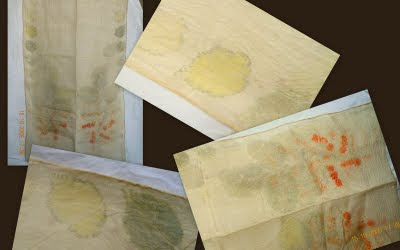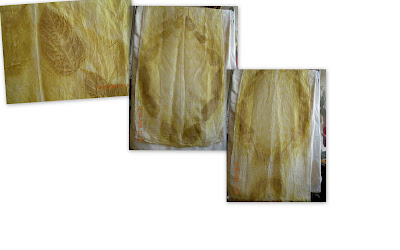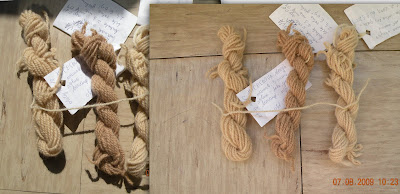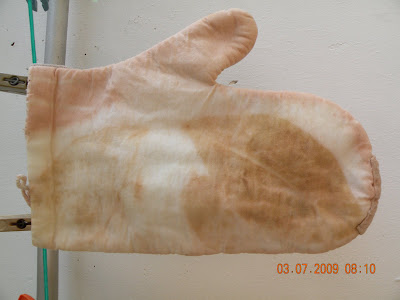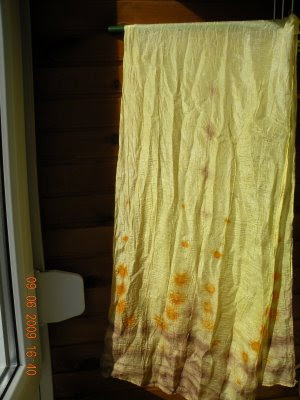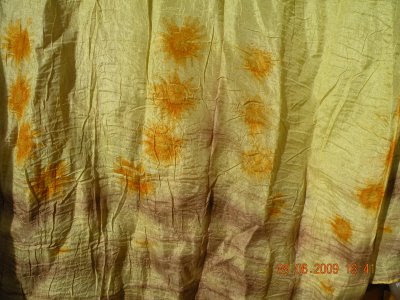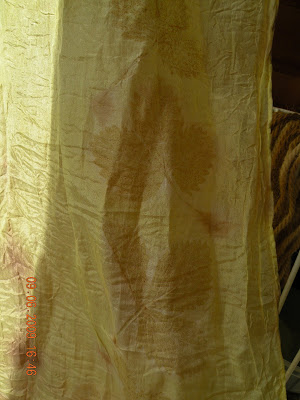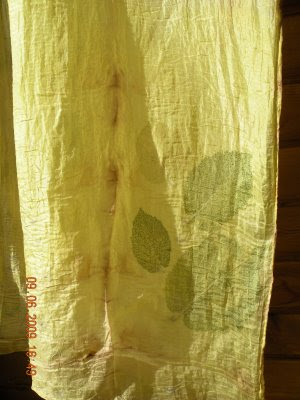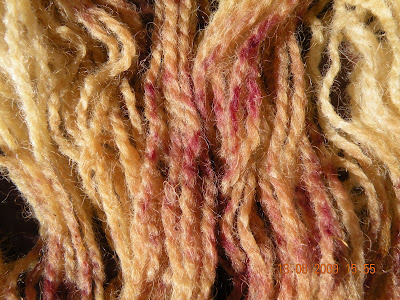 Našla sem novo rastišče šentjanževke, precej blizu doma, le nekaj kilometrov stran. Volneno prejo sem pobarvala kontaktno samo s cvetki. Rezultat me je tako navdušil, da sem morala slikati še mokro volno, čeprav sem vedela, da posušena ne bo več tako živih barv.
I found a new growing area of St. John's wort, quite near my home, not more than a couple of kilometers away. I contact-dyed wool yarn with flowers only. The result filled me with such enthusiasm that I just had to take a picture of wet yarn although I knew well it won't keep the vivid colours when dried.
Našla sem novo rastišče šentjanževke, precej blizu doma, le nekaj kilometrov stran. Volneno prejo sem pobarvala kontaktno samo s cvetki. Rezultat me je tako navdušil, da sem morala slikati še mokro volno, čeprav sem vedela, da posušena ne bo več tako živih barv.
I found a new growing area of St. John's wort, quite near my home, not more than a couple of kilometers away. I contact-dyed wool yarn with flowers only. The result filled me with such enthusiasm that I just had to take a picture of wet yarn although I knew well it won't keep the vivid colours when dried.
 Res barve niso več tako žive, vijolična je šla proti rjavi (pa ne toliko, kot je videti na sliki), ampak volna je še vedno čudovita.
Res barve niso več tako žive, vijolična je šla proti rjavi (pa ne toliko, kot je videti na sliki), ampak volna je še vedno čudovita.
Indeed, the colours are not so vivid any more, the burgundy-purple shifted towards brown (not as much as in the picture, though), but the wool is still marvelous.
 Navila sem jo še z malo napravico, da lahko nit vlečem iz sredine klobke.
Navila sem jo še z malo napravico, da lahko nit vlečem iz sredine klobke.
I wound it using a small appliance to be able to pull the yarn from the middle of the ball.
 Takole je videti spletena, gladko desne na licu.
Takole je videti spletena, gladko desne na licu.
This is how it looks when knit, stockinette stich.
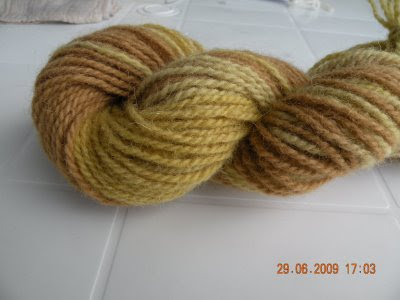

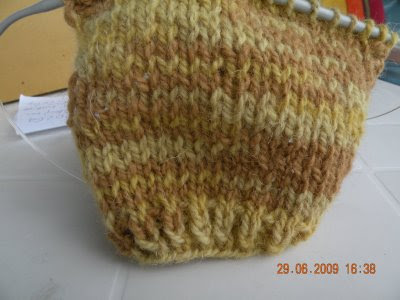
Pred nekaj tedni me je premamil blog Helen Melvin, ki je dobila zanimivo barvo z zlato rozgo tik pred cvetenjem. Rezultat je bilo razočaranje - nezanimiva rumena (razen prvega barvanja, ki je dalo močno živorumeno). Odločila sem se, da bom volno prebarvala po delih. Del sem pobarvala z izrabljeno barvilno kopeljo iz rabarbarinih listov in del z izrabljeno kopeljo zelenih orehov. Barve sicer niso ravno moje najljubše, kombinacija pa mi je zelo všeč in sem zdaj prav zadovoljna z rezultatom barvanja, pa še izrabljene barvilne kopeli sem karseda porabila.
Some weeks ago I was tempted by Helen Melvin's report of an interesting colour obtained from goldenrod just prior to bloom. My result was a disappointment - an uninteresting yellow (except for the first dyeing which gave a vivid and strong yellow) so I decided to partly overdye the skeins. I used a rhubarb leaves exhaust bath and a green walnuts exhaust bath for parts of the skein. Although the colours are not just my choice I like their combination very much and am quite happy with the result now. In addition, I made utmost use of my exhaust dyebaths.



 Letos sem božične in novoletne voščilnice izdelala na svojem ročno izdelanem papirju, na katerega sem prilepila sličice jaslic ali svete družine (in jih zaprla v kuverte, preden sem pomislila, da bi jih bilo dobro fotografirati, ojoj).
Na druge sem prilepila kartončke z zvezdo repatico, večje in manjše pozlačene zvezdice, narisala zlatega angelčka skozi šablono - kot vidite na zgornjih fotografijah.Zraven sem poslušala in si prepevala božične pesmi in preživela res lepe urice v mislih na vse tiste, ki sem jim voščilnice poslala.
This year I made my Christmas and New Year Cards with my handmade paper. I glued pictures of Nativity or the Holy Family on them - and closed the envelopes before it occurred to me it would be wise to take some photos :-(
I made others by gluing smaller pieces of carton with a Christmas Star, small and large stars painted gold, draw a golden angel using a template - as may be seen in the above pictures. While doing this I listened to and sang Christmas carols. I spent really pleasant hours thinking of those I was going to send the cards.
Letos sem božične in novoletne voščilnice izdelala na svojem ročno izdelanem papirju, na katerega sem prilepila sličice jaslic ali svete družine (in jih zaprla v kuverte, preden sem pomislila, da bi jih bilo dobro fotografirati, ojoj).
Na druge sem prilepila kartončke z zvezdo repatico, večje in manjše pozlačene zvezdice, narisala zlatega angelčka skozi šablono - kot vidite na zgornjih fotografijah.Zraven sem poslušala in si prepevala božične pesmi in preživela res lepe urice v mislih na vse tiste, ki sem jim voščilnice poslala.
This year I made my Christmas and New Year Cards with my handmade paper. I glued pictures of Nativity or the Holy Family on them - and closed the envelopes before it occurred to me it would be wise to take some photos :-(
I made others by gluing smaller pieces of carton with a Christmas Star, small and large stars painted gold, draw a golden angel using a template - as may be seen in the above pictures. While doing this I listened to and sang Christmas carols. I spent really pleasant hours thinking of those I was going to send the cards.


